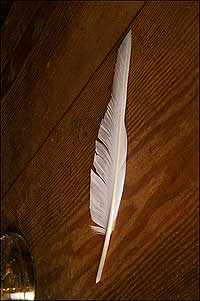Page content
 Quill pen. Quill pen.Click image to enlarge |
QUILL PENS date to the Dark Ages, when bird feathers replaced the hollow reeds the Romans used. To make a quill pen, you first had to catch your bird. Goose feathers were favored. Swan quills were the best, but who would approach an angry swan? Crow feathers, it is said, were unbeatable for drawing fine lines.
Thomas Jefferson bred special geese to keep himself in writing implements. Because of their shape, only the five feathers at the tip of the left wing would do—left-handers could use feathers from the right wing—and it was best to pull them in the spring. The trick then was to bury the feathers in hot, dry sand to harden the points, after which it was time to get your penknife out: the better the cut, the finer the script.
After a couple of ink-spattered pages, it was time to retrim the nib. If you were lucky, your quill might last a week. Small wonder Britain imported twenty-seven million quills a year from Russia alone.
For almost 1,500 years, people used quill pens to write letters. By the middle of the nineteenth century, however, steel nibs were well on their way to ousting the trusty quill.
Then, in the twentieth, along came the fountain pen, the ball point, the fiberpoint, the roller ball, the gel-point.
